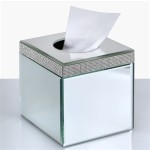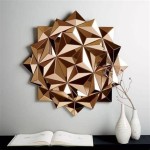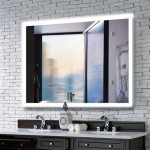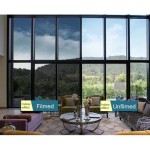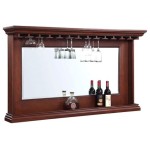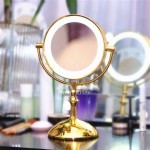How To Angle A Mirror On Wall With Hooks
Angling a mirror on the wall using hooks offers a versatile way to customize its reflection and fit specific spaces. This approach allows for adjustable positioning and can accommodate various mirror sizes and weights. The following guide outlines the process and considerations for successfully angling a mirror on hooks.
Key Considerations Before Starting
Several factors influence the process of angling a mirror. Careful planning ensures a secure and aesthetically pleasing result.
- Mirror Weight and Size: Heavier and larger mirrors require more robust hooks and potentially additional support.
- Wall Material: The wall's composition dictates the appropriate hook type and anchoring method. Drywall necessitates different hardware than concrete or brick.
- Desired Angle: Visualize the desired reflection before installation to determine the necessary hook placement and angling.
- Hook Type: Select hooks specifically designed for mirrors, considering their weight capacity and aesthetic compatibility.
Choosing the Right Hooks
Hook selection is crucial for both functionality and safety. Understanding different hook types is essential for optimal support.
- Heavy-Duty Mirror Hooks: Often featuring two or more mounting points, these hooks provide increased stability for heavier mirrors.
- D-Ring Hangers with Hooks: D-rings attached to the back of the mirror paired with corresponding hooks offer a secure hanging solution.
- Adjustable Mirror Clips: These clips grip the mirror's edges and allow for minor angle adjustments after installation.
- French Cleats: While technically not hooks, French cleats offer a robust and discreet method, especially for larger, heavier mirrors. They provide a secure interlocking system that can bear significant weight and also allow for some tilting.
Preparing the Wall and Mirror
Proper preparation ensures a smooth and successful installation.
- Locate Wall Studs: If possible, mount hooks into wall studs for maximum support. A stud finder helps identify their location.
- Mark Hook Positions: Precise marking is critical for achieving the desired angle. Use a level and measuring tape for accuracy.
- Install Anchors (if necessary): If studs are not available, use appropriate wall anchors that match the wall material and the weight of the mirror.
- Attach Hanging Hardware to the Mirror: Securely attach D-rings, wire, or other hanging mechanisms to the back of the mirror according to the manufacturer's instructions.
Installing the Hooks and Angling the Mirror
Careful installation ensures the mirror is securely mounted at the desired angle.
- Install the Hooks: Screw the hooks into the wall at the marked positions, ensuring they are firmly in place.
- Hang the Mirror: Carefully hang the mirror on the hooks, ensuring it is stable.
- Adjust the Angle: If using adjustable hooks or clips, fine-tune the mirror's angle until the desired reflection is achieved.
- Check for Stability: Gently push on the mirror's edges to ensure it is securely mounted and will not shift.
Angling Techniques for Specific Effects
Different angling techniques achieve specific reflective results.
- Downward Tilt: Tilting the mirror slightly downwards can be useful for viewing oneself from head to toe.
- Upward Tilt: This can enhance light reflection within a room, especially if positioned opposite a window.
- Sideways Tilt: Angling the mirror sideways can create interesting visual effects and suit particular design aesthetics.
Safety Precautions
Safety is paramount when working with mirrors and wall-mounted installations.
- Wear Safety Glasses: Protect eyes from potential debris during drilling and installation.
- Use Appropriate Tools: Employ the correct drill bits and screwdrivers for the wall material and hook type.
- Enlist Help for Large Mirrors: Heavy or large mirrors require assistance to prevent accidents during installation.
- Regularly Check for Stability: Periodically inspect the hooks and mounting hardware to ensure the mirror remains securely in place.
Maintaining the Angled Mirror
Proper maintenance ensures the mirror remains securely mounted and in good condition.
- Clean the Mirror Regularly: Use appropriate glass cleaner and a soft cloth to maintain its reflective surface.
- Inspect the Hooks and Hardware: Periodically check for signs of wear, loosening, or damage.
- Tighten Screws as Needed: If any screws become loose, carefully tighten them to maintain the mirror's stability.
How To Hang A 100 Pound Mirror On Drywall Quora

How To Hang A Frameless Mirror On The Wall With Pictures

How To Hang A Heavy Mirror Or Picture True Value

How To Hang A Mirror

Mirror Hanging Hang Mirrors With Brackets Hooks Rails Hanger Kits

Gymax Full Length Over The Door Mirror Hanging Hooks Wall Mount Dressing White Com

Gymax 13 In W X 47 H Modern Rectangle Wood Full Length Over The Door Mirror Hanging Hooks Wall Mount Dressing Black Gym10444 Home Depot

Tangkula Full Length Over The Door Mirror Hanging Hooks Wall Mount Dressing Black Target

63inches Free Standing Mirror Full Length Floor Mirroreasel Dressing With Angle Adjustable Wall Mounted For Hallway Entryway White Steel Bhus Qh 1712 Com

Arched Mirror Wall Organizer With Hooks Tassels Key Holder For Dog Leash Jewelry Mask

